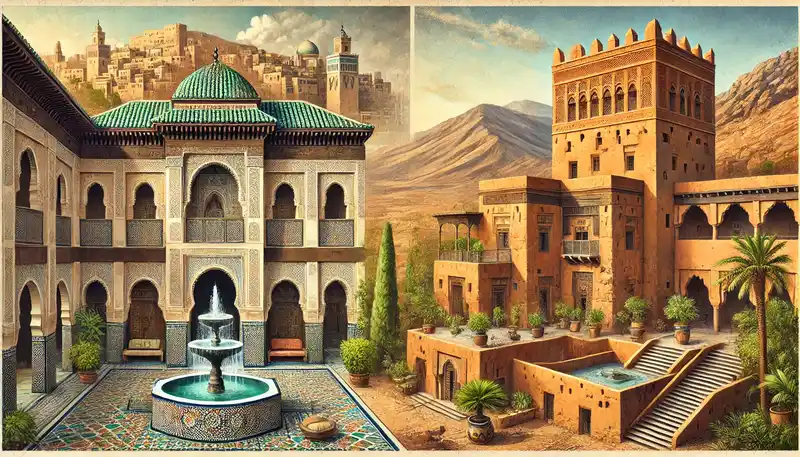What is the Difference Between a Riad and a Kasbah?
Explore the key differences between riads and kasbahs, their historical significance, uses, and discover popular examples in Morocco’s iconic cities.

Morocco is a land of mesmerizing architecture, blending historical significance with exquisite artistry. Among its most iconic structures are riads and kasbahs. These two architectural marvels have distinct characteristics, purposes, and histories. Understanding their differences offers a deeper appreciation of Morocco’s rich cultural heritage.
What is a Riad?
A riad is a traditional Moroccan house or palace with an interior garden or courtyard. The term “riad” comes from the Arabic word “riyad,” meaning “garden.” These homes are designed to provide privacy and tranquility, with a focus on inward-facing architecture.
Key Features of a Riad
- Central Courtyard: The heart of every riad is a courtyard, often adorned with a fountain, zellige tiles, and lush plants.
- Ornate Decor: Riads are celebrated for intricate wood carvings, stucco work, and colorful mosaics.
- Inward-Facing Design: Windows and doors typically face the courtyard, ensuring privacy and protection from external noise.
- Small Scale: Most riads are two to three stories tall and provide an intimate atmosphere.
Main Uses of a Riad
Historically, riads were private residences for wealthy families. Today, many have been converted into boutique hotels, offering guests an authentic Moroccan experience.
What is a Kasbah?
A kasbah, on the other hand, is a fortress or fortified residence, often perched on hilltops or near strategic locations. The term “kasbah” originates from the Arabic word “qasabah,” meaning “fortress.” These structures were built to defend against invasions and often housed leaders or tribal chiefs.
Key Features of a Kasbah
- Thick Walls: Constructed from rammed earth or adobe, kasbahs have sturdy walls to withstand attacks.
- Towers: Most kasbahs feature defensive towers at each corner.
- Strategic Location: Positioned near trade routes, rivers, or mountain passes for protection and control.
- Simple Interiors: Unlike riads, kasbah interiors are functional rather than decorative.
Main Uses of a Kasbah
Kasbahs were historically used as military strongholds, administrative centers, and residences for rulers. Some have been transformed into museums or luxury accommodations.
Historical Significance
Both riads and kasbahs reflect Morocco’s rich history and diverse influences, from Andalusian art to Berber traditions. Riads flourished in urban settings like Marrakech and Fes, embodying the grandeur of Moroccan city life. Kasbahs, rooted in Berber culture, were vital in rural and strategic regions, symbolizing resilience and authority.
Moroccan Cities Known for Riads and Kasbahs
Marrakech
Riads:
- Riad El Fenn: A luxury riad with vibrant decor, blending traditional and contemporary styles.
- Riad Kniza: A 200-year-old riad renowned for its intimate ambiance and exceptional service.
- Riad Yasmine: Famous for its stunning courtyard pool and Instagram-worthy aesthetic.
Kasbahs:
- Kasbah Tamadot: Nestled in the Atlas Mountains, this luxurious kasbah offers breathtaking views.
- Kasbah Agafay: Located just outside Marrakech, it provides a serene desert escape.
- Kasbah Bab Ourika: Perched on a hilltop, offering panoramic views of the Atlas Mountains and valleys.
Fes
Riads:
- Riad Fès: Known for its opulent Andalusian-style architecture and luxurious amenities.
- Riad Laaroussa: A beautifully restored 17th-century riad with an enchanting courtyard.
- Dar Seffarine: A blend of historical charm and modern comfort in the heart of the medina.
Kasbahs:
- Kasbah of Chefchaouen: While Chefchaouen is more renowned for its blue walls, its kasbah offers historical insights.
- Kasbah Boulaouane: A fortress overlooking the Oum Er-Rbia River, known for its strategic importance.
- Kasbah Cherarda: Situated near Fes, it once served as a military outpost.
Ouarzazate
Riads:
- Riad Ksar Ighnda: A tranquil retreat with traditional Moroccan decor near Ait Benhaddou.
- Dar Chamaa: Combining modern comfort with classic Moroccan design.
- Riad Tama: Perfect for exploring Ouarzazate and its surroundings.
Kasbahs:
- Kasbah Ait Benhaddou: A UNESCO World Heritage site and iconic film location.
- Kasbah Taourirt: Once home to the powerful Glaoui family, showcasing intricate clay architecture.
- Kasbah Tifoultoute: Overlooking the Oued Ouarzazate River, offering stunning views and historical significance.
Comparing Riads and Kasbahs
| Feature | Riad | Kasbah |
|---|---|---|
| Purpose | Residential | Defensive |
| Location | Urban centers | Rural or strategic sites |
| Design | Ornate, inward-facing | Sturdy, outward-facing |
| Cultural Influence | Andalusian | Berber |
| Current Use | Boutique hotels, private homes | Museums, luxury stays |
Exploring Morocco’s Architectural Gems
Visiting riads and kasbahs provides a glimpse into Morocco’s history and artistry. Riads offer a peaceful retreat in bustling cities, while kasbahs transport visitors to a time of resilience and grandeur. Both serve as a testament to Morocco’s architectural ingenuity and cultural legacy.
Whether you’re wandering the medinas of Marrakech, exploring the ancient streets of Fes, or venturing into the dramatic landscapes of Ouarzazate, the allure of riads and kasbahs is undeniable. Plan your trip to experience these iconic structures and immerse yourself in Morocco’s timeless beauty.